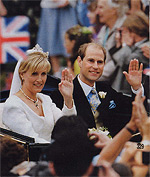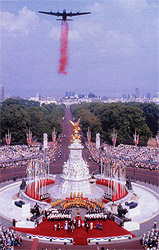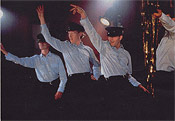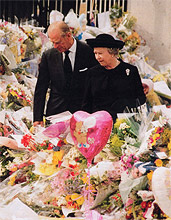|
1990's - The Technological Nineties
|
|
Royal Weddings
 When Lady Helen Windsor, the only daughter of the Duke and Duchess of Kent, married art dealer Tim Taylor in St George’s Chapel, Windsor, in 1992, it was the first royal wedding to be held in the chapel for nearly 90 years – and the last until Edward and Sophie’s wedding in 1999. When Lady Helen Windsor, the only daughter of the Duke and Duchess of Kent, married art dealer Tim Taylor in St George’s Chapel, Windsor, in 1992, it was the first royal wedding to be held in the chapel for nearly 90 years – and the last until Edward and Sophie’s wedding in 1999.
St Margaret’s Church, Westminster, was the venue for the wedding of Limerick-born heiress Serena Stanhope to Viscount Linley, only son of Princess Margaret and Lord Snowdon, in 1993.
The following year, 1994, saw the wedding of Princess Margaret’s daughter, Lady Sarah Armb-Jones to fellow artist Daniel Chatto at Wren’s exquisite St Stephen Walbrook Church in the City of London.
At the end of the decade, in 1999, came the wedding of the Queen’s youngest son, Prince Edward, who became the Earl of Wessex, to Sophie Rhys-Jones, who became the Countess of Wessex. |
|
50th Anniversary WWII
 The summer of commemoration marking the end of the Second World War 50 years earlier came to a dignified and sombre close in September 1995. Some 25,000 of the ‘forgotten armies’ of men and women who had struggled on in the Far East after the European conflict ended, together with civilians and ex-prisoners of war, gathered in The Mall to hear the Last Post. The summer of commemoration marking the end of the Second World War 50 years earlier came to a dignified and sombre close in September 1995. Some 25,000 of the ‘forgotten armies’ of men and women who had struggled on in the Far East after the European conflict ended, together with civilians and ex-prisoners of war, gathered in The Mall to hear the Last Post.
As the service ended the Queen drove down The Mall escorted by the Duke of York to watch the veterans march past. Prince Philip, who had served as a junior naval officer in the Pacific, and had been present at the Japanese surrender in Yokohama Bay, left the Queen’s side to march with his old comrades.
Then, with a roar, the still summer air was shattered as the nation’s last airworthy Lancaster bomber flew above The Mall, sending a million red poppies raining down.
The day ended on a spectacular note when Dame Vera Lynn pressed the button that launched an unprecedented great firework display.
|
|
British Films
 British films of the Forties and Fifties were characterised by wartime thrillers, quirky Ealing comedies and, towards the end of the Fifties and into the Sixties, gutsy ‘kitchen sink’ dramas. British films of the Forties and Fifties were characterised by wartime thrillers, quirky Ealing comedies and, towards the end of the Fifties and into the Sixties, gutsy ‘kitchen sink’ dramas.
But by the Nineties, British films could no longer be classified by type. From classic epics to gentle comedies, clever animations and cutting-edge social observation, the British film industry produced it all.
1994’s ‘Four Weddings and a Funeral’ and ‘The Full Monty’, made in 1997, are the most successful films Britain has ever made. Although the latter cost only $3.5m to make, it took $167m at box offices worldwide.
Costume drama proved a risky genre, but 1999’s ‘Shakespeare in Love’ won a clutch of awards, including the Oscar for Best Picture.
|
|
Supermodels
 During the Nineties a handful of stunning women dominated the catwalks, billboards and fashion advertisements. They were young, famous and beautiful and they wouldn’t get out of bed for less than $10,000. They were the supermodels who dated stars, threw the occasional tantrum and were hoisted on pedestals as icons of style and beauty. During the Nineties a handful of stunning women dominated the catwalks, billboards and fashion advertisements. They were young, famous and beautiful and they wouldn’t get out of bed for less than $10,000. They were the supermodels who dated stars, threw the occasional tantrum and were hoisted on pedestals as icons of style and beauty.
They looked like a million dollars and they were soon worth considerably more. Earning $2,500 an hour, $50,000 to appear exclusively in a Versace show, and $600,000 plus for a big contract, these new models had the fashion industry eating out of their hands.
For some of them, along with the fame came celebrity boyfriends: Cindy Crawford married Richard Gere; Kate Moss dated Johnny Depp; while Naomi Campbell can count Robert DeNiro and Mike Tyson among her ex-beaux. Other names that took the catwalk by storm are Linda Evangelista, Claudia Schiffer and Helena Christensen.
|
|
Computers, Lottery, Stars
When it comes to everyday electronics, the Nineties was responsible for arming most of us with a mobile phone, a personal computer and CD’s, as well as the Internet and DVD’s. Kids fell for the ‘Teletubbies’, while Tamagotchi virtual pets were a short-lived sensation. Cooking became something you watched a celebrity chef doing on the telly, while you yourself gorged the offerings from one of the many local takeaways.
The new National Lottery filled the tabloids with rags-to-riches stories, and millions of pounds went to good causes. As the decade ended, we became captivated by ‘Who Wants to Be a Millionaire’, sharing the agony and angst as -- despite the endless going ‘fifty-fifty’, ‘phoning a friend’ and ‘asking the audience’ – the tantalising £1 million proved elusive in the Nineties.
Famous faces in the news: Elizabeth Hurley and Chris Evans were rarely out of the headlines. The Spice Girls put Girl Power on the agenda, while the decade took Robbie Williams from being a Take That heart-throb to a fully-fledged singer-songwriter, ‘Millennium’ star and all-round entertainer.
|
|
Diana Killed
 Just as when President Kennedy was shot dead, everybody can remember where they were when they heard the unbelievable and devastating news of Diana’s death. In Britain, on that fateful Sunday Morning, in 1997, we had just woken up. The radio announced the awful news and played music that was more sombre than usual, and this went on for days. Just as when President Kennedy was shot dead, everybody can remember where they were when they heard the unbelievable and devastating news of Diana’s death. In Britain, on that fateful Sunday Morning, in 1997, we had just woken up. The radio announced the awful news and played music that was more sombre than usual, and this went on for days.
A grieving nation paid instant, heartfelt tribute to the woman everybody felt they knew because the press had hounded her for years. Diana had always been big news, not only because of her extra-marital affairs and subsequent divorce but also because of her wonderful dress sense that had made her a fashion icon.
Killed in a high-speed car accident in Paris at the age of 36 while escaping the paparazzi, she was a mother who had recently found happiness with Dodi Fayed, who died alongside her. Within hours of her death, a mountain of flowers appeared outside her home at Kensington Palace, and also outside Buckingham Palace..
The words of Elton John’s tribute song to her sum it all up:“Goodbye English Rose”.
|
|
|


